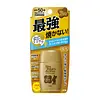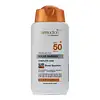What's inside
What's inside
 Key Ingredients
Key Ingredients

 Benefits
Benefits

 Concerns
Concerns

 Ingredients Side-by-side
Ingredients Side-by-side

Cyclopentasiloxane
EmollientWater
Skin ConditioningZinc Oxide
Cosmetic ColorantEthylhexyl Methoxycinnamate
UV AbsorberCetyl Ethylhexanoate
EmollientDipropylene Glycol
HumectantSilica
AbrasiveDimethicone
EmollientTitanium Dioxide
Cosmetic ColorantCetyl PEG/PPG-10/1 Dimethicone
EmulsifyingMagnesium/Aluminum/Zinc/Hydroxide/Carbonate
Polyglyceryl-3 Diisostearate
EmulsifyingDiethylamino Hydroxybenzoyl Hexyl Benzoate
UV FilterHydrogen Dimethicone
Myristic Acid
CleansingAluminum Hydroxide
EmollientTocopheryl Acetate
AntioxidantMethylparaben
PreservativeEthylparaben
PreservativePotassium Alum
AstringentParfum
MaskingButylene Glycol
HumectantDimethicone/Vinyl Dimethicone Crosspolymer
Skin ConditioningBHT
AntioxidantGlycyrrhetinic Acid
Skin ConditioningCamellia Sinensis Leaf Extract
AntimicrobialScutellaria Baicalensis Root Extract
AstringentCyclopentasiloxane, Water, Zinc Oxide, Ethylhexyl Methoxycinnamate, Cetyl Ethylhexanoate, Dipropylene Glycol, Silica, Dimethicone, Titanium Dioxide, Cetyl PEG/PPG-10/1 Dimethicone, Magnesium/Aluminum/Zinc/Hydroxide/Carbonate, Polyglyceryl-3 Diisostearate, Diethylamino Hydroxybenzoyl Hexyl Benzoate, Hydrogen Dimethicone, Myristic Acid, Aluminum Hydroxide, Tocopheryl Acetate, Methylparaben, Ethylparaben, Potassium Alum, Parfum, Butylene Glycol, Dimethicone/Vinyl Dimethicone Crosspolymer, BHT, Glycyrrhetinic Acid, Camellia Sinensis Leaf Extract, Scutellaria Baicalensis Root Extract
Water
Skin ConditioningEthylhexyl Methoxycinnamate
UV AbsorberIsododecane
EmollientDimethicone
EmollientButyl Methoxydibenzoylmethane
UV AbsorberEthylhexyl Salicylate
UV AbsorberGlycerin
HumectantNeopentyl Glycol Diheptanoate
EmollientCetearyl Alcohol
EmollientSilica
AbrasiveEthylhexyl Triazone
UV AbsorberHydrolyzed Jojoba Esters
Skin ConditioningMethylene Bis-Benzotriazolyl Tetramethylbutylphenol
UV FilterPolymethylsilsesquioxane
Titanium Dioxide
Cosmetic ColorantCeteareth-20
CleansingSaccharide Isomerate
HumectantPhenoxyethanol
PreservativeCetyl Alcohol
EmollientGlyceryl Stearate
EmollientChlorphenesin
AntimicrobialPolysorbate 80
EmulsifyingPEG-75 Stearate
Acrylates/C10-30 Alkyl Acrylate Crosspolymer
Emulsion StabilisingDecyl Glucoside
CleansingSodium Acrylate/Sodium Acryloyldimethyl Taurate Copolymer
Emulsion StabilisingXanthan Gum
EmulsifyingCeteth-20
CleansingSteareth-20
CleansingIsohexadecane
EmollientDisodium EDTA
Benzophenone-3
UV AbsorberHamamelis Virginiana Water
AstringentAloe Barbadensis Leaf Juice
Skin ConditioningPropylene Glycol
HumectantSorbitan Oleate
EmulsifyingCitric Acid
BufferingSodium Citrate
BufferingPolygonum Aviculare Extract
EmollientMelanin
Skin ProtectingPalmitoyl Tripeptide-5
Skin ConditioningPotassium Sorbate
PreservativeSodium Benzoate
MaskingPentylene Glycol
Skin ConditioningBenzoic Acid
MaskingEthylhexylglycerin
Skin ConditioningWater, Ethylhexyl Methoxycinnamate, Isododecane, Dimethicone, Butyl Methoxydibenzoylmethane, Ethylhexyl Salicylate, Glycerin, Neopentyl Glycol Diheptanoate, Cetearyl Alcohol, Silica, Ethylhexyl Triazone, Hydrolyzed Jojoba Esters, Methylene Bis-Benzotriazolyl Tetramethylbutylphenol, Polymethylsilsesquioxane, Titanium Dioxide, Ceteareth-20, Saccharide Isomerate, Phenoxyethanol, Cetyl Alcohol, Glyceryl Stearate, Chlorphenesin, Polysorbate 80, PEG-75 Stearate, Acrylates/C10-30 Alkyl Acrylate Crosspolymer, Decyl Glucoside, Sodium Acrylate/Sodium Acryloyldimethyl Taurate Copolymer, Xanthan Gum, Ceteth-20, Steareth-20, Isohexadecane, Disodium EDTA, Benzophenone-3, Hamamelis Virginiana Water, Aloe Barbadensis Leaf Juice, Propylene Glycol, Sorbitan Oleate, Citric Acid, Sodium Citrate, Polygonum Aviculare Extract, Melanin, Palmitoyl Tripeptide-5, Potassium Sorbate, Sodium Benzoate, Pentylene Glycol, Benzoic Acid, Ethylhexylglycerin
 Reviews
Reviews

Ingredients Explained
These ingredients are found in both products.
Ingredients higher up in an ingredient list are typically present in a larger amount.
Dimethicone is a type of synthetic silicone created from natural materials such as quartz.
What it does:
Dimethicone comes in different viscosities:
Depending on the viscosity, dimethicone has different properties.
Ingredients lists don't always show which type is used, so we recommend reaching out to the brand if you have questions about the viscosity.
This ingredient is unlikely to cause irritation because it does not get absorbed into skin. However, people with silicone allergies should be careful about using this ingredient.
Note: Dimethicone may contribute to pilling. This is because it is not oil or water soluble, so pilling may occur when layered with products. When mixed with heavy oils in a formula, the outcome is also quite greasy.
Learn more about DimethiconeEthylhexyl Methoxycinnamate is an organic compound that provides UVB protection. It often goes by the more common name of octinoxate. It is created from methoxycinnamic acid and 2-ethylhexanol.
Ethylhexyl Methoxycinnamate absorbs UVB rays with wavelengths between 280-320 nm. UV absorbers protect your skin by using chemical reactions to convert UV rays into heat and energy.
UVB (290-320 nm) rays emit more energy than UVA rays. They are capable of damaging DNA, causing sunburns and are thought to be linked to skin cancer.
The state of Hawaii has banned sunscreens containing octinoxate due to its potential impact on coral reefs. More research is needed to bridge gaps in this research. The European Union allows higher levels of octinoxate in sunscreens than the US and Australia.
Ethylhexyl Methoxycinnamate is oil soluble. It is not stable and may lose efficacy when exposed to sunlight.
Learn more about Ethylhexyl MethoxycinnamateSilica, also known as silicon dioxide, is a naturally occurring mineral. It is used as a fine, spherical, and porous powder in cosmetics.
Though it has exfoliant properties, the function of silica varies depending on the product.
The unique structure of silica enhances the spreadability and adds smoothness, making it a great texture enhancer.
It is also used as an active carrier, emulsifier, and mattifier due to its ability to absorb excess oil.
In some products, tiny microneedles called spicules are made from silica or hydrolyzed sponge. When you rub them in, they lightly polish away dead skin layers and enhance the penetration of active ingredients.
Learn more about SilicaTitanium dioxide is a mineral UV filter widely used in sunscreens and cosmetics.
It is one of only two UV filters officially classified as “mineral” by regulatory agencies, the other being zinc oxide.
Titanium dioxide provides broad-spectrum protection mostly in the UVB and UVAII range, with some protection in the UVAI range.
While its UVA protection isn’t as strong as zinc oxide’s, the difference is minor.
A common myth is that mineral UV filters reflect UV light. However, modern research shows titanium dioxide absorbs UV radiation like chemical filters (~95% absorption & 5% reflection).
Thanks to its non-irritating nature, titanium dioxide is suitable for sensitive, acne-prone, or redness-prone skin. It is unlikely to cause "eye sting" like other sunscreen ingredients.
A major drawback of this ingredient is its white cast and thick texture. This is why mineral sunscreens often leave a white cast and are less cosmetically elegant than chemical/hybrid sunscreens.
To improve white cast and spreadability, micronized or nano-sized titanium dioxide is often used.
There are ongoing concerns surrounding nano-titanium oxide's impact on marine ecosystems.
There is no conclusive evidence that any form of titanium oxide (or any other sunscreen ingredients) will cause harm to marine ecosystems or coral reefs. The science is still developing but many consumers are keeping a close eye on this issue.
Please note, many destinations have reef-safety sunscreen rules. For instance, the U.S. Virgin Islands advises all visitors to use non-nano mineral sunscreens.
Nano mineral sunscreens once raised safety concerns about absorption into skin.
Extensive research has shown that they do not penetrate healthy or damaged skin; they remain safely on the surface and the top layer of dead skin (stratum corneum).
You'll likely find titanium dioxide bundled with alumina, silica, or dimethicone. These ingredients help make titanium dioxide highly photostable; this prevents it from interacting with other formula components under UV light.
Learn more about Titanium DioxideWater. It's the most common cosmetic ingredient of all. You'll usually see it at the top of ingredient lists, meaning that it makes up the largest part of the product.
So why is it so popular? Water most often acts as a solvent - this means that it helps dissolve other ingredients into the formulation.
You'll also recognize water as that liquid we all need to stay alive. If you see this, drink a glass of water. Stay hydrated!
Learn more about Water